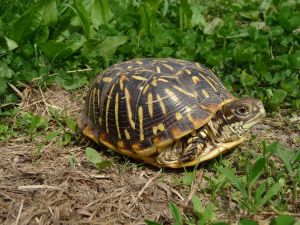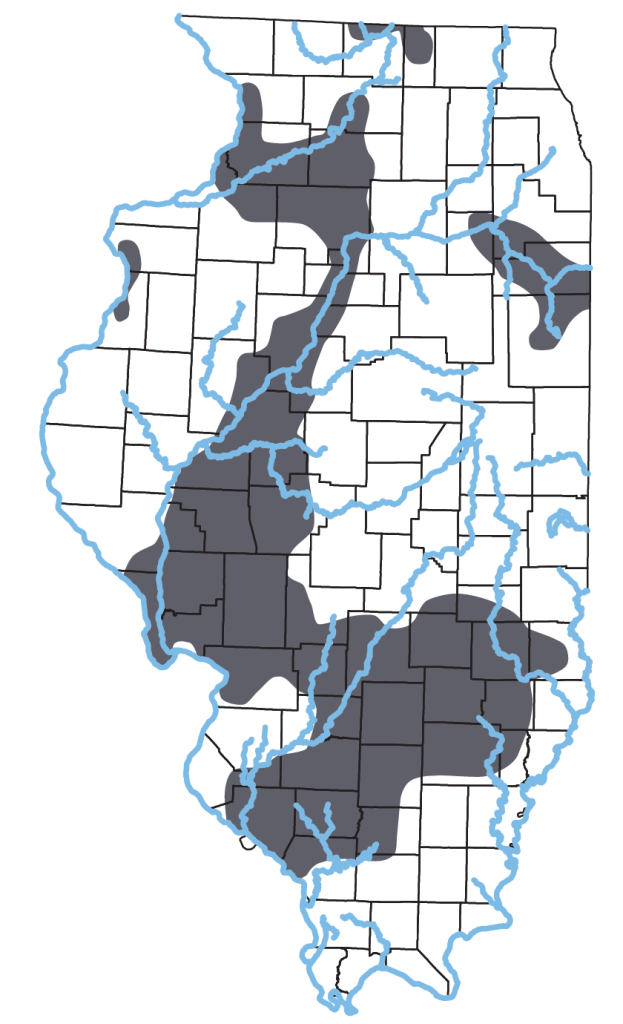Terrapene ornata (Agassiz, 1857)

Key Characters: Moderately high carapace flattened along midline and without keel; hinged plastron patterned with yellow lines radiating from center of each scute.
Similar Species: The Eastern Box Turtle, T. carolina, is generally larger, has a more domed carapace with a vertebral keel, and has a plain plastron without straight yellow lines. The Blanding’s Turtle, Emydoidea blandingii, is much larger, has a yellow plastron with a black blotch on the distal portion of each plastral plate (some older individuals may have a predominantly black plastron), and a yellow throat. See Key to Adult Turtles of Illinois for help with identification.
Subspecies: Two subspecies are currently recognized; Plains Box Turtle, T. o. ornata, and Desert Box Turtle, T. o. luteola, Smith and Ramsey, 1952 (Wasmann J. Biol. 10(1):45-54). Only T. o. ornata inhabits Illinois.
Description: A medium-sized (up to 13 cm CL) terrestrial turtle with dark brown carapace, yellow midback stripe and yellow lines radiating from center of each scute (6-8 lines per pleural scute). Plastron patterned with yellow lines on dark scutes. Head sometimes spotted. Male differs from female by having slightly concave plastron, red rather than brown eyes, more posteriorly located anus, and sharply recurved first claw of the hindfoot. Smith (1961) noted that approximately 30% of the males he examined (n =14) from the sand prairies of central and northern Illinois had uniformly green or blue heads, while only 5% of the 44 specimens from the southern outlier prairies had this bizarre head coloring. Hatchling resembles adult, but yellow markings are more like spots than lines. Older adults tend to have widely flaring marginals (Smith, 1961, Illinois Natural History Survey Bulletin 28. Article 1).
Habitat: Sand prairies of central and northern Illinois, Southern Tillplain prairies (clay soil outlier prairies) and open fields in former prairie.
Natural History: Tends to be more carnivorous than eastern box turtle, but eats some vegetation. Eats mainly insects, but also snails, earthworms, tadpoles, bird eggs and hatchlings, and carrion. Female lays one or more clutches of 4-6 ellipsoidal, relatively hard-shelled eggs (ca. 35 x 20 mm) in June. Hibernates about two weeks earlier than eastern box turtle, and emerges in spring about two weeks later.
Status: Uncommon to rare in much of its range in Illinois. Threatened.
Etymology: Terrapene – (New Latin) from the Native American (Algonquin) word for turtle; ornata – (Latin) meaning embellishment, fancy.
Original Description: Agassiz, L. 1857. Contributions to the natural history of the United States of America. first monograph. vol. 1, part 2. North American Testudinidae. Little, Brown, & Co., Boston. p. 233 – 452d.
Type Specimen: Not designated. There is much confusion surrounding the status of possible syntypes. See Ward (1978, Cat. N. Amer. Amphibians and Reptiles, 217.1 – 217.4) for a thourough discussion.
Type Locality: “from the upper Misouri … and from Iowa”. Erroneously restricted to Council Bluffs, Iowa by Smith & Taylor (1950, Bull. U.S. Natl. Mus.199:1-253) and to junction of the Platte and Missouri River by Schmidt (1953, Checklist 6th ed.); restriction corrected to Burlington, Iowa by Lectotype designation of Smith & Smith (1980 [1979], Synopsis of the Herpetofauna of Mexico, Vol. 6, Guide to Mexican Turtles. Bibliographic Addendum 3).
Original Name: Cistudo ornata Agassiz, 1857
Nomenclatural History/ Other Notes: H. Garman was the first to include this species in the Illinois herpetofauna under the name Cistudo ornata (1892. A synopsis of the reptiles and amphibians of Illinois. Illinois Laboratory of Natural History Bulletin 3(13):215-388). Smith (1961, Illinois Natural History Survey Bulletin 28. Article 1) regarded six specimens he examined to be hybrids with T. carolina and examined hybridization in more detail in a separate paper (Smith. 1955. Natural History Miscellanea 146:1–3). For more data on hybridization between T. ornata and T. carolina, see Clark, (1935. Copeia 1935:148–150); Blaney (1968. Proceedings of the Louisiana Academy of Science 31:54–57); Lutterschmidt et al. (2007. Southeastern Naturalist 6:571–576) and Cureton et al. (Copeia 2011(2):270-277).


